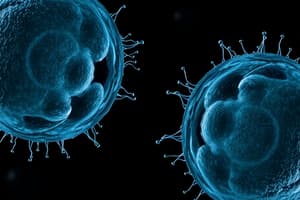Podcast
Questions and Answers
What happens during metaphase in mitosis?
What happens during metaphase in mitosis?
- Chromosomes are aligned at the metaphase plate. (correct)
- The nuclear envelope completely dissolves.
- Sister chromatids are pulled apart to opposite poles.
- Spindle fibers begin to disassemble.
Which of the following is NOT a phase of mitosis?
Which of the following is NOT a phase of mitosis?
- Cytokinesis (correct)
- Prophase
- Anaphase
- Telophase
What is the role of cyclins and cyclin-dependent kinases (CDKs) in the cell cycle?
What is the role of cyclins and cyclin-dependent kinases (CDKs) in the cell cycle?
- They regulate the progression through cell cycle checkpoints. (correct)
- They facilitate the separation of sister chromatids.
- They help in the formation of the spindle apparatus.
- They promote the decondensation of chromosomes.
What is the primary function of mitosis in multicellular organisms?
What is the primary function of mitosis in multicellular organisms?
Which statement accurately describes the process of cytokinesis?
Which statement accurately describes the process of cytokinesis?
Flashcards are hidden until you start studying
Study Notes
Mitosis Overview
- Mitosis is the process of cell division in eukaryotic cells, resulting in two genetically identical daughter cells.
- It is essential for growth, tissue repair, and asexual reproduction.
Phases of Mitosis
-
Prophase
- Chromatin condenses into visible chromosomes (sister chromatids).
- Nuclear envelope begins to break down.
- Spindle fibers form from centrosomes and attach to kinetochores on chromosomes.
-
Metaphase
- Chromosomes align at the metaphase plate (equatorial plane).
- Spindle fibers are fully formed and connected to each chromosome.
-
Anaphase
- Sister chromatids are pulled apart to opposite poles of the cell by spindle fibers.
- Each chromatid is now considered an individual chromosome.
-
Telophase
- Chromosomes reach the poles and begin to decondense back to chromatin.
- Nuclear envelope reforms around each set of chromosomes.
- Spindle apparatus begins to disassemble.
Cytokinesis
- Follows mitosis, dividing the cytoplasm of the parent cell into two daughter cells.
- In animal cells, a cleavage furrow forms, pinching the cell membrane.
- In plant cells, a cell plate develops between the two nuclei, leading to cell wall formation.
Regulation of Mitosis
- Controlled by cell cycle checkpoints (G1, G2, and M checkpoints).
- Key proteins involved: cyclins and cyclin-dependent kinases (CDKs).
- Errors in mitosis can lead to aneuploidy or cancer.
Key Points
- Mitosis is a form of asexual reproduction in unicellular organisms.
- In multicellular organisms, it plays a critical role in development and tissue maintenance.
- Mitosis ensures genetic continuity by producing daughter cells with the same DNA content as the parent cell.
Mitosis Overview
- Cell division in eukaryotes resulting two genetically identical daughter cells
- Essential for growth, tissue repair, and asexual reproduction
Phases of Mitosis
- Prophase: Chromatin condenses into visible chromosomes (sister chromatids), nuclear envelope breaks down, spindle fibers form from centrosomes
- Metaphase: Chromosomes align at the metaphase plate, spindle fibers fully formed and connected to each chromosome
- Anaphase: Sister chromatids are pulled apart to opposite poles of the cell by spindle fibers, each chromatid is now considered an individual chromosome
- Telophase: Chromosomes reach the poles and begin to decondense back to chromatin, nuclear envelope reforms, spindle apparatus begins to disassemble
Cytokinesis
- Divides the cytoplasm of the parent cell into two daughter cells
- In animal cells, a cleavage furrow forms, pinching the cell membrane
- In plant cells, a cell plate develops between the two nuclei, leading to cell wall formation
Regulation of Mitosis
- Controlled by cell cycle checkpoints (G1, G2, and M checkpoints)
- Key proteins involved: cyclins and cyclin-dependent kinases (CDKs)
- Errors in mitosis can lead to aneuploidy or cancer
Key Points
- Mitosis is a form of asexual reproduction in unicellular organisms
- In multicellular organisms, it plays a critical role in development and tissue maintenance
- Mitosis ensures genetic continuity by producing daughter cells with the same DNA content as the parent cell
Studying That Suits You
Use AI to generate personalized quizzes and flashcards to suit your learning preferences.




